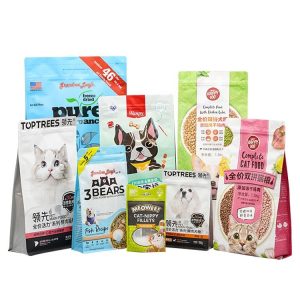Introduction For Pet Food Bag
Benefits of Proper Pet Food Storage
Properly storing your pet’s food in airtight containers provides several advantages over keeping it in the original bag. An appropriate pet food storage container keeps kibble fresh longer, protects against pests, and makes it easier to scoop out portions.
Keeps Food Fresher Longer
Pet food bags are not totally airtight or waterproof. Exposure to air and moisture causes kibble to lose freshness and become stale more quickly. Storing in an airtight pet food bin preserves the original freshness longer.
Protects Against Pests
Pests like ants, roaches, and moths can chew into flimsy pet food bags. Transferring kibble to insect-proof storage containers keeps it safe from infestations. Hard plastic or stainless steel bins prevent pests from getting in.
Easier to Dispense Portions
Scooping food out of a bag can be messy and inconvenient. Pet food containers often have pour spouts or scoops built-in to easily measure out portions. This simplifies feeding time and reduces waste.
Types of Pet Food Containers
There are several common materials used to make pet food storage containers, each with their own pros and cons.
Plastic Pet Food Containers
Plastic bins are affordable, lightweight, and come in a variety of sizes. Look for BPA-free food-grade plastic. The main downside is durability issues like cracking over time.
Metal Pet Food Containers
Stainless steel and aluminum are very durable materials resistant to corrosion and dents. Metal bins are chew-proof and fully opaque to block light. However, they can be more expensive.
Ceramic Pet Food Containers
Ceramic containers have an attractive look and feel. Dense ceramic is impermeable to moisture and air. The drawbacks are heavy weight and fragility risks if dropped.
Key Features to Look For
Certain features make pet food containers more convenient and effective for storing kibble. Consider if the bin you’re looking at has these useful design elements:
Airtight Seal
A lid with a tight seal prevents air and moisture from entering, keeping food fresher longer. Rubber gaskets provide the best airtight closure.
Durable Material
Look for sturdy construction that resists cracking or deforming over years of use. Thicker plastic, stainless steel, or ceramic last longer.
Easy-Open Lid
Pet owners will be taking the lid on and off frequently. Hinged lids and snap latches make accessing the food inside more convenient.
Stackable Design
For multi-pet households, stackable bins allow fitting multiple containers together neatly. This saves space.
Matching Container Size to Pet
Pick a pet food storage bin with ample capacity for your pet’s needs. Here are some general guidelines on sizes based on pet type:
Small Pets: 1-6 Cups
Dogs under 25 lbs, cats, and small animals like guinea pigs will only need a small container up to 6 cups. This portable size is great for travel.
Medium Pets: 10-20 Cups
Most average sized dogs do well with a 10-20 cup mid-sized storage bin. This capacity holds 15-30 lbs of kibble.
Large Pets: 25+ Cups
For big dogs over 50 lbs who eat a lot, choose a large 25+ cup industrial-sized bin. This holds up to 50 lbs of food. Jumbo bins keep refilling to a minimum.
Maintaining and Cleaning Containers
To keep pet food bins working properly and hygienic, be sure to:
Wash Regularly
Every few weeks, hand wash or run through the dishwasher. Use hot water and pet-safe detergent. Rinse thoroughly. Air dry completely.
Inspect for Damage
Check for cracks, warped surfaces, loose hinges, etc. This ensures no moisture or pests can get in. Replace if damaged.
Replace When Worn
Normal wear eventually damages seal integrity. Every year or two, replace old containers with fresh new bins.
In summary, storing your pet’s dry food in an appropriate container provides big benefits. Durable, airtight bins with pet-friendly features make feeding time easier while keeping kibble fresher and safer from pests. Regular cleaning and replacement ensures your containers remain effective. With the right storage solution, your pet gets kibble that stays fresh and delicious.
FAQs
Q: Are pet food containers airtight?
A: High quality pet food containers are designed to be fully airtight to preserve freshness, with a rubber gasket around the lid to seal out air and moisture. Cheaper bins may not have an airtight seal.
Q: Should pet food bins be transparent or opaque?
A: Opaque bins are best, as light exposure can degrade nutrients in kibble over time. Look for plastic containers treated to block UV or metal/ceramic bins that no light penetrates.
Q: How often should pet food containers be cleaned?
A: Give pet food bins a thorough wash every 2-4 weeks. Clean immediately if any mold, moisture, or bugs appear. Use hot water and a pet-safe detergent.
Q: Should pet food bins be stored in the pantry or garage?
A: Pantry storage is ideal, as garages expose containers to greater temperature fluctuations and pests. Keep bins in a climate-controlled area.
Q: What is the best material for pet food storage?
A: Stainless steel is very durable, airtight, chew-proof, and easy to clean. Plastic or ceramic are cheaper but more prone to damage over time.
Q: How can you get rid of odors in pet food bins?
A: Try soaking bins in a diluted vinegar solution, then rinse and air dry. Baking soda or activated charcoal can also absorb stubborn odors when left in container overnight.







Leave A Comment